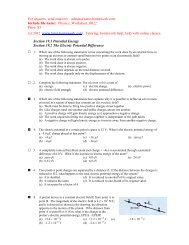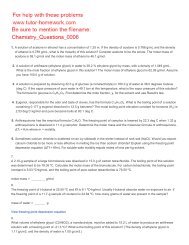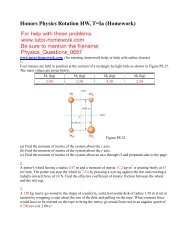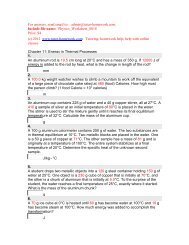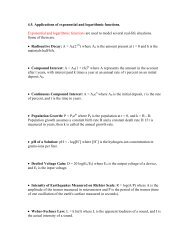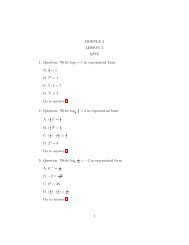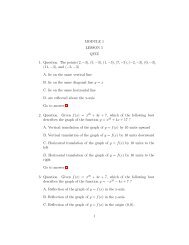www.tutor-homework.com (for tutoring, homework help, or help with ...
www.tutor-homework.com (for tutoring, homework help, or help with ...
www.tutor-homework.com (for tutoring, homework help, or help with ...
Create successful ePaper yourself
Turn your PDF publications into a flip-book with our unique Google optimized e-Paper software.
<strong>www</strong>.<strong>tut<strong>or</strong></strong>-<strong>homew<strong>or</strong>k</strong>.<strong>com</strong> (<strong>f<strong>or</strong></strong> <strong>tut<strong>or</strong></strong>ing, <strong>homew<strong>or</strong>k</strong> <strong>help</strong>, <strong>or</strong> <strong>help</strong> <strong>with</strong> online classes)<br />
Question 1<br />
2 / 2 points<br />
Which electron energy will produce the largest cutoff wavelength <strong>f<strong>or</strong></strong> X-ray production from a nickel (Z = 28)<br />
surface?<br />
a) 40 keV<br />
b) 35 keV<br />
c) 30 keV<br />
d) 45 keV<br />
e) 25 keV<br />
Question 2<br />
Consider the following list of electron configurations:<br />
(1) 1s 2 2s 2 3s 2 (4) 1s 2 2s 2 2p 6 3s 2 3p 6 4s 2<br />
(2) 1s 2 2s 2 2p 6 (5) 1s 2 2s 2 2p 6 3s 2 3p 6 4s 2 3d 6<br />
(3) 1s 2 2s 2 2p 6 3s 1<br />
2 / 2 points<br />
Reference: Ref 30-3<br />
Which one of the above configurations represents a transition element?<br />
a) 5<br />
b) 3<br />
c) 4<br />
d) 2<br />
e) 1<br />
Question 3<br />
2 / 2 points<br />
Complete the following statement: An individual copper atom emits electromagnetic radiation <strong>with</strong><br />
wavelengths that are<br />
a) the same as other elements in the same column of the periodic table.<br />
b) unique to that particular copper atom.<br />
c) evenly spaced across the spectrum.<br />
d) the same as those of all elements.<br />
e) unique to all copper atoms.<br />
Question 4<br />
Why was it necessary <strong>f<strong>or</strong></strong> Bohr to require that electrons remain in stationary <strong>or</strong>bits?<br />
a) No two electrons can be in the same region in the atom.<br />
b) An electron must travel in a circular path.<br />
c) It was required by the Heisenberg uncertainty principle.<br />
d) Classical physics predicts that the electron should spiral into the nucleus.<br />
e) It was required by the Pauli exclusion principle.<br />
Question 5<br />
2 / 2 points<br />
2 / 2 points
The figure shows an energy level diagram <strong>f<strong>or</strong></strong> the hydrogen atom. Several transitions are shown and are<br />
labeled by letters.<br />
Note: The diagram is not drawn to scale.<br />
Reference: Ref 30-4<br />
Determine the energy of the photon involved in transition E.<br />
a) 1.5 eV<br />
b) 12.1 eV<br />
c) 3.4 eV<br />
d) 10.2 eV<br />
e) 1.9 eV<br />
Question 6<br />
2 / 2 points<br />
The figure shows an energy level diagram <strong>f<strong>or</strong></strong> the hydrogen atom. Several transitions are shown and are<br />
labeled by letters.<br />
Note: The diagram is not drawn to scale.<br />
Reference: Ref 30-4<br />
Which transition will occur when a hydrogen atom is irradiated <strong>with</strong> radiation of wavelength 103 nm?<br />
a) A<br />
b) D<br />
c) B<br />
d) E
e) C<br />
Question 7<br />
2 / 2 points<br />
Which one of the following fact<strong>or</strong>s best explains why the six electrons of a carbon atom are not all in the 1s<br />
state?<br />
a) electron spin<br />
b) Ruther<strong>f<strong>or</strong></strong>d model of atomic structure<br />
c) Pauli exclusion principle<br />
d) Coulomb's law<br />
e) Heisenberg uncertainty principle<br />
Question 8<br />
An atom will emit photons when one of its electrons goes from<br />
a) the M shell to the N shell.<br />
b) the K shell to the M shell.<br />
c) the K shell to the L shell.<br />
d) the N shell to the L shell.<br />
e) the K shell to the N shell.<br />
Question 9<br />
Use the Bohr model to estimate the K α X-ray wavelength <strong>f<strong>or</strong></strong> a gold atom (Z = 79).<br />
a) 2.47 × 10 –13 m<br />
b) 2.00 × 10 –11 m<br />
c) 3.60 × 10 –11 m<br />
d) 5.13 × 10 –10 m<br />
e) 8.54 × 10 –10 m<br />
2 / 2 points<br />
2 / 2 points<br />
Question 10<br />
2 / 2 points<br />
The kinetic energy of the ground state electron in hydrogen is +13.6 eV. What is its potential energy?<br />
a) +27.2 eV<br />
b) –27.2 eV<br />
c) –13.6 eV<br />
d) zero eV<br />
e) +56.2 eV



